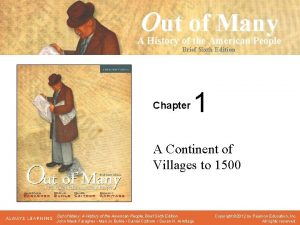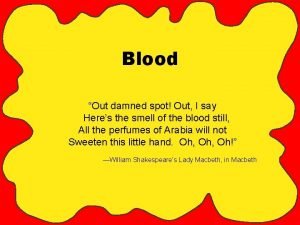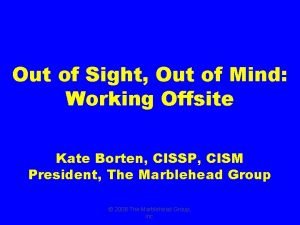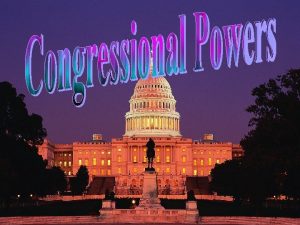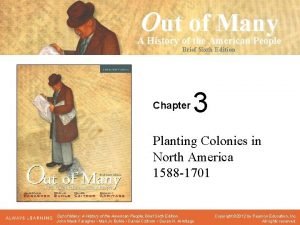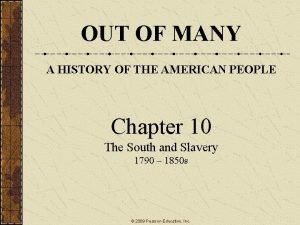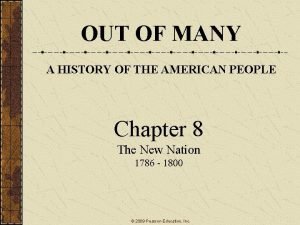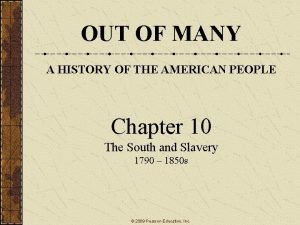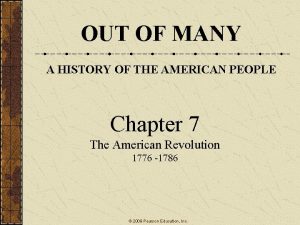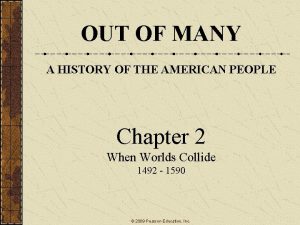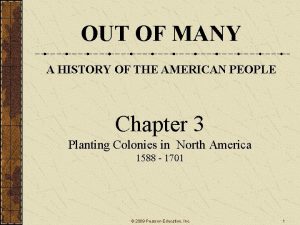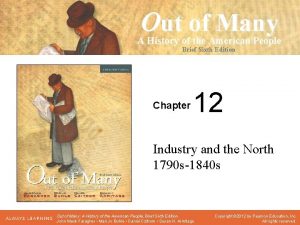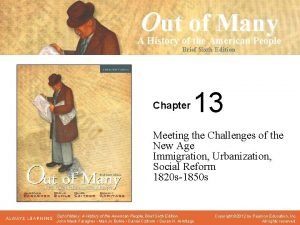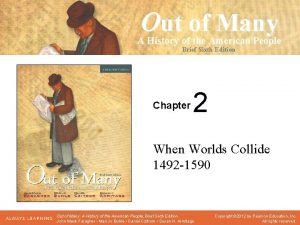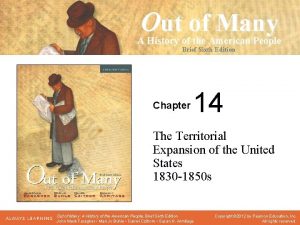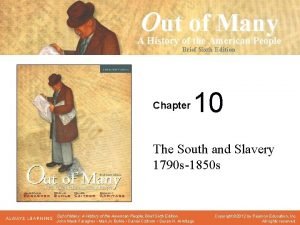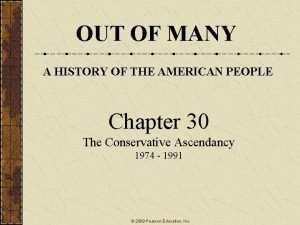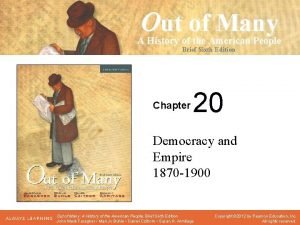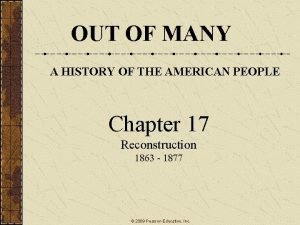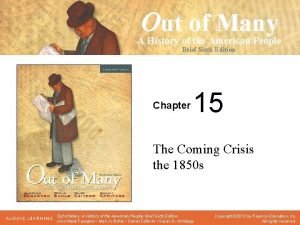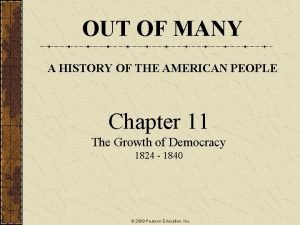OUT OF MANY A HISTORY OF THE AMERICAN






















































- Slides: 54

OUT OF MANY A HISTORY OF THE AMERICAN PEOPLE Chapter 5 The Cultures of Colonial North America 1700 - 1780 © 2009 Pearson Education, Inc.

Part One Introduction © 2009 Pearson Education, Inc. 2

Chapter Focus Questions What were the similarities and differences among eighteenth-century Spanish, French, and British colonies? What was the impact on British culture of increasing European immigration? In what ways did Indian America change as a result of contact with European customs and life ways? What were the patterns of work and class in eighteenthcentury North America? How did tension between Enlightenment thought and traditional culture lead to the Great Awakening? © 2009 Pearson Education, Inc. 3

Part Two American Communities: The Revival of Religion and Community in Northampton © 2009 Pearson Education, Inc. 4

American Communities: The Revival of Religion and Community in Northampton Jonathan Edwards, a preacher from Northampton, Massachusetts, was an originator of emotional preaching. He aimed his revivals at young, disaffected adults. This disaffection created the conditions for the Great Awakening. © 2009 Pearson Education, Inc. 5

Part Three North American Regions © 2009 Pearson Education, Inc. 6

North American Region Map: Regions in Eighteenth-Century North America © 2009 Pearson Education, Inc. 7

MAP 5. 1 Regions in Eighteenth-Century North America By the middle of the eighteenth century, European colonists had established a number of distinctive colonial regions in North America. The northern periphery of New Spain, the oldest and most prosperous European colony, stretched from Baja California to eastern Texas, then jumped to the settlements on the northern end of the Florida peninsula; cattle ranching was the dominant way of life in this thinly populated region. New France was like a great crescent, extending from the plantation communities along the Mississippi near New Orleans to the French colonial communities along the St. Lawrence; in between were isolated settlements and forts connected only by the extensive French trading network. © 2009 Pearson Education, Inc. 8

North American Regions Indians showed capacity to adapt and change by participating in the commercial economy, using metal tools, and building homes of logs as frontier settlers did. But, Indians also became dependent on European trade goods. Diplomatically, Indians played colonial powers off against each other. The major concern of Indians was the phenomenal growth of the colonial population in the British coastal communities. Simultaneously, Indian populations continued to decline. Table: Population of North America in 1750 © 2009 Pearson Education, Inc. 9

A portrait of the Delaware chief Tishcohan by Gustavus Hesselius, painted in 1732. In his purse of chipmunk hide is a clay pipe, a common item of the Indian trade. Tishcohan was one of the Delaware leaders forced by Pennsylvania authorities into signing a fraudulent land deal that reversed that colony’s history of fair dealing with Indians over land. He moved west to the Ohio River as settlers poured into his former homeland. SOURCE: Gustavus Hesselius, “Tishcohan”, Native American Portrait, 1735. Courtesy of the Historical Society of Pennsylvania Collection, Atwater Kent Museum of Philadelphia. © 2009 Pearson Education, Inc. 10

© 2009 Pearson Education, Inc. 11

North American Regions Map: Growing Use of the Horse by Plains Indians The introduction of the horse stimulated the rise of nomadic Plains culture. © 2009 Pearson Education, Inc. 12

MAP 5. 2 Growing Use of the Horse by Plains Indians In the seventeenth and eighteenth centuries, Spanish settlers introduced horses into their New Mexican colony. Through trading and raiding, horses spread northward in streams both west and east of the Rocky Mountains. The horse, whose genetic ancestor had been native to the American continent in pre-Archaic times, offered the Indian peoples of the Great Plains the opportunity to create a distinctive hunting and warrior culture. © 2009 Pearson Education, Inc. 13

The Spanish Borderlands The viceroyalty of New Spain was the largest and most prosperous European colony in North America. The northern borderlands of New Spain were considered a buffer zone of protection from other European colonies. In Florida, the colonial presence was weak causing the Spanish to form alliances with Indians and runaway slaves to create a multiracial society. In New Mexico, the population expanded by developing ranches and farms along the Rio Grande River. © 2009 Pearson Education, Inc. 14

A mounted Soldado de Cuera (Leather-Coated Soldier), a watercolor by Ramón de Murillo, c. 1803. Thick leather coats offered protection from Indian arrows for the cavalry posted to the northern frontiers of eighteenth-century New Spain. © 2009 Pearson Education, Inc. 15

The Spanish Borderlands In California, the mission system guided development in the 1770 s. As shown by the mission system, the Catholic Church played a dominant role in community life. Indians were needed to raise the necessary subsistence. Indians were not forced to join but once they joined they were not allowed to leave. They were attracted by the food, clothing, and tools that promised a higher standard of living. © 2009 Pearson Education, Inc. 16

The Church of San Xavier del Bac, constructed in the late eighteenth century, is located a few miles south of the city of Tucson, where Jesuit Father Eusebio Kino founded a mission among the Pima Indians in 1700. Known as the White Dove of the Desert, it is acclaimed as the most striking example of Spanish colonial architecture in the United States. © 2009 Pearson Education, Inc. 17

The French Crescent Map: The French Crescent The Catholic Church played a strong role in the French colonies. For defensive reasons, the French allied with Indian trading partners to set up a line of military posts and settlements. Throughout Quebec, the French established farming communities that shipped wheat to Louisiana plantations. French communities combined French and Indian elements in architecture, dress, and family patterns. © 2009 Pearson Education, Inc. 18

MAP 5. 3 The French Crescent The French empire in North America was based on a series of alliances and trade relations with Indian nations linking a great crescent of colonies, settlements, and outposts that extended from the mouth of the St. Lawrence River, through the Great Lakes, and down the Mississippi River to the Gulf of Mexico. In 1713, Acadia was ceded to the British, but the French established the fortress of Louisbourg to anchor the eastern end of the crescent. © 2009 Pearson Education, Inc. 19

The persistence of French colonial long lots in the pattern of modern landholding is clear in this enhanced satellite Photograph of the Mississippi River near New Orleans. Long lots, the characteristic form of property holding in New France, were designed to offer as many settlers as possible a share of good bottomland as well as a frontage on the waterways, which served as the basic transportation network. © 2009 Pearson Education, Inc. 20

New England Puritan congregations governed local communities. Mix of freedom and repression Attempts to introduce religious toleration failed as other denominations practiced their faith openly by 1700. New England towns grew rapidly and the expanding population pressed against available land. © 2009 Pearson Education, Inc. 21

The Turner House (immortalized by Nathaniel Hawthorne in his novel The House of the Seven Gables) in Salem, Massachusetts, was constructed in the seventeenth century. In this style of architecture, function prevailed over form as structures grew to accommodate their residents; rooms were added where and when they were needed. In England, wood for building was scarce, but the abundance of forests in North America created the conditions for a golden age of wood construction. SOURCE: Photograph courtesy Peabody Essex Museum. © 2009 Pearson Education, Inc. 22

The Middle Colonies New York had one of the most ethnically diverse populations in North America. New York City grew tremendously but immigration to rural areas was lower than surrounding areas. Pennsylvania Quakers accepted a more diverse population. Government institutions were pillars of community organization. Middle Colony communities were more individualistic than the tightly controlled New England communities. © 2009 Pearson Education, Inc. 23

This view of the Philadelphia waterfront, painted about 1720, conveys the impression of a city firmly anchored to maritime commerce. The long narrow canvas was probably intended for display over the mantel of a public room. SOURCE: Peter Cooper, “The South East Prospect of the City of Philadelphia, ” ca. 1720. The Library Company of Philadelphia. © 2009 Pearson Education, Inc. 24

The Backcountry Map: Spread of Settlement: Movement into the Backcountry, 1720– 60 Backcountry was a distinctive region where rank was often of little concern. Most pioneers owned little or no land. “Big men” held large tracts and dominated local communities. Men were warriors; women were domestic workers. Conflicts between settlers and Indians made the backcountry a violent region. © 2009 Pearson Education, Inc. 25

MAP 5. 4 Spread of Settlement: Movement into the Backcountry, 1720– 60 The spread of settlement from 1720 to 1760 shows the movement of population into the backcountry during the midcentury. © 2009 Pearson Education, Inc. 26

Seeing History A Plan of an American New Cleared Farm. © 2009 Pearson Education, Inc. 27

The South was a triracial society of Europeans, Africans, and Indians. Large plantation homes dominated the Upper and Lower South. Small tobacco farms were widely found in the Upper South. White males dominated southern society. In the Upper South, well-developed neighborhoods created a sense of community and white solidarity. © 2009 Pearson Education, Inc. 28

Traditional Culture in the New World In the colonies, everyday life revolved around the family and kinship, the church, and the local community. Americans were attached to their regional cultures which were based on oral transmission. Community needs outweighed those of the individual. The majority of rural Americans were self-sufficient farmers who practiced diverse agriculture and engaged in crafts on the side. In cities, artisans were organized according to the European craft system. Women had few career opportunities. © 2009 Pearson Education, Inc. 29

A spinner and carpenter from The Book of Trades, an eighteenth-century British survey of the crafts practiced in colonial America. In colonial cities, artisans organized themselves into the traditional European craft system with apprentices, journeymen, and masters. There were few opportunities for the employment of women outside the household, but women sometimes earned income by establishing sidelines as midwives or spinners. . © 2009 Pearson Education, Inc. 30

The Frontier Heritage Land in America was abundant and cheap but did not lead to a democratic society. Forced labor was common and few indentured servants won freedom and prosperity. The demand for land caused wars with Indians. Puritans argued that Indians were failing to use the land to the utmost capacity. Violence and brutality were considered an essential part of colonial life. © 2009 Pearson Education, Inc. 31

Part Four Social and Political Patterns © 2009 Pearson Education, Inc. 32

Population Growth and Immigration Chart: Estimated Total Population of New Spain, New France, and the British North American Colonies, 1700– 1780 In 1700, 290, 000 colonists lived north of Mexico. In 1750, the colonial population had grown to almost 1. 3 million. High fertility and low mortality played important roles. An abundance of food contributed to good health. © 2009 Pearson Education, Inc. 33

FIGURE 5. 1 Estimated Total Population of New Spain, New France, and the British North American Colonies, 1700– 1780 Although the populations of all three North American colonial empires grew in the eighteenth century, the explosive growth of the British colonies was unmatched. SOURCE: Historical Statistics of the United States (Washington, DC: Government Printing Office, 1976), 1168. © 2009 Pearson Education, Inc. 34

Population Growth and Immigration Map: Ethnic Groups in Eighteenth. Century British North America Chart: The Ancestry of the British Colonial Population Only the British colonies encouraged immigration. The British also encouraged immigration from foreign nations. © 2009 Pearson Education, Inc. 35

MAP 5. 5 Ethnic Groups in Eighteenth-Century British North America The first federal census, taken in 1790, revealed remarkable ethnic diversity. New England was filled with people from the British Isles, but the rest of the colonies were a patchwork. Most states had at least three different ethnic groups within their borders, and although the English and Scots-Irish were heavily represented in all colonies, in some they had strong competition from Germans (eastern and southern Pennsylvania) and from African peoples (Virginia and South Carolina). © 2009 Pearson Education, Inc. 36

FIGURE 5. 2 The Ancestry of the British Colonial Population The legacy of eighteenth-century immigration to the British colonies was a population of unprecedented ethnic diversity. SOURCE: Thomas L. Purvis, “The European Ancestry of the United States Population, ” William and Mary Quarterly 61 (1984): 85 – 101. © 2009 Pearson Education, Inc. 37

Social Class North American society was not aristocratic, but it was not without social hierarchy. In New Spain status was based on racial purity. In New France and New Spain hereditary ranks and styles from the Old World prevailed. In the British colonies, the elite was open and based on wealth. Social mobility was present and common. The large middle class was a new social phenomena. There was also a large lower class. © 2009 Pearson Education, Inc. 38

An eighteenth-century genre painting from New Spain showing various racial castas, the result of ethnic mixing. © 2009 Pearson Education, Inc. 39

Economic Growth and Increasing Inequality Table: Wealth Held by Richest 10 Percent of Population in British Colonial America, 1770 French and Spanish colonies were economically stagnant compared to the booming British colonies. Over time in the British colonies, the gap between rich and poor increased, especially in cities and commercial farming regions. In older regions, land shortage created a population of “strolling poor. ” Chart: Distribution of Assessed Taxable Wealth in Eighteenth-Century Chester County © 2009 Pearson Education, Inc. 40

© 2009 Pearson Education, Inc. 41

FIGURE 5. 3 Distribution of Assessed Taxable Wealth in Eighteenth-Century Chester County This graph charts the concentration of assets in the hands of wealthy families. From 1693 to 1802, the percentage of total wealth held by the richest 10 percent of taxpayers rose from 24 to 38 percent, while the percentage held by the poorest 60 percent of taxpayers fell from 39 to 18 percent. This pattern was typical for regions dominated by commerce. SOURCE: James Lemon and Gary Nash, “The Distribution of Wealth in Eighteenth-Century America, ” Journal of Social History 2 (1968): 1 – 24. © 2009 Pearson Education, Inc. 42

Contrasts in Colonial Politics Unlike the French and Spanish, the British used a decentralized form of government. Royal governors and locally elected assemblies governed. Most adult white males could vote. Colonial politics were characterized by deference rather than democracy. Leadership was entrusted to men of high rank and wealth. Most colonial assemblies had considerable power over local affairs because they controlled finances. © 2009 Pearson Education, Inc. 43

Part Five The Cultural Transformation of British North America © 2009 Pearson Education, Inc. 44

The Cultural Transformation of British North America The British colonies were more open to intellectual and religious challenges than the French and Spanish. Literacy widespread in British colonies British colonial officials made little attempt at cultural censorship. © 2009 Pearson Education, Inc. 45

The Enlightenment Challenge Enlightenment ideas emphasized rationality, harmony, and order. The state existed to provide for happiness and security of individuals who were endowed with rights of life, liberty, and property. Enlightenment ideas Traditional views also had strong popular appeal. Colleges held to a mixture of traditional and enlightened views. © 2009 Pearson Education, Inc. 46

The first page of the New England Primer (1689), published in Boston, which in its various editions sold more than 5 million copies. In addition to the letters of the alphabet, illustrated by crude but charming woodcuts and couplets, the book contained simple moral texts based on Biblical history and wisdom. © 2009 Pearson Education, Inc. 47

A Decline in Religious Devotion The spread of new ideas occurred during a period of religious decline. The Puritan Church experienced falling membership and attendance at services. The change from a congregational to an established church contributed to the Puritan decline. © 2009 Pearson Education, Inc. 48

In this satirical British cartoon of 1760 evangelist George Whitefield preaches to a crowd of listeners while holding a bag of “cash. ” The crowd below adds critical comment, one man remarking that the “Rev. Mr. Humbug” is worth no more than a “halfpenny, ” and the woman next to him wishing that Whitefield’s “spirit was in my flesh. ” Source: Copyright the British Museum. © 2009 Pearson Education, Inc. 49

The Great Awakening In the 1730 s, the Great Awakening began with Jonathan Edwards calling for a return to Puritan traditions that appealed to dissatisfied young people. The movement spread as thousands of people experienced emotional conversions. In 1738, George Whitefield toured America, further fueling the movement. Conflicts developed between Old and New Lights. In the South, the Great Awakening introduced Christianity to slaves. The Great Awakening greatly increased church membership. © 2009 Pearson Education, Inc. 50

Baptism by Full Immersion in the Schuylkill River of Pennsylvania, an engraving by Henry Dawkins illustrating events in the history of American Baptists, was published in Philadelphia in 1770. With calls for renewed piety and purity, the Great Awakening reinvigorated American Protestantism. The Baptists preached an egalitarian message, and their congregations in the South often included both white and black Protestants. SOURCE: Henry Dawkins, “Baptismal Ceremony Beside he Schuylkill. ” Engraving, 1770, John Carter Brown Library at Brown University. © 2009 Pearson Education, Inc. 51

The Politics of Revivalism had political implications. Revivalism offered people the first chance to participate in public debate. It empowered ordinary people to challenge their leaders. © 2009 Pearson Education, Inc. 52

Part Six Conclusion © 2009 Pearson Education, Inc. 53

© 2009 Pearson Education, Inc. 54
 Mounds
Mounds One direction one thing
One direction one thing Put out the light othello
Put out the light othello Robert frost poems
Robert frost poems Outta sight outta mind quotes
Outta sight outta mind quotes Out out robert frost macbeth
Out out robert frost macbeth Loto safety talk
Loto safety talk Poem out out by robert frost
Poem out out by robert frost Lily gulledge
Lily gulledge Matthew 11 28 the message
Matthew 11 28 the message Loto
Loto Out, damned spot! out, i say!
Out, damned spot! out, i say! Harmony not discord
Harmony not discord Makna out of sight out of mind
Makna out of sight out of mind Log out tag out deutsch
Log out tag out deutsch Hát kết hợp bộ gõ cơ thể
Hát kết hợp bộ gõ cơ thể Frameset trong html5
Frameset trong html5 Bổ thể
Bổ thể Tỉ lệ cơ thể trẻ em
Tỉ lệ cơ thể trẻ em Voi kéo gỗ như thế nào
Voi kéo gỗ như thế nào Glasgow thang điểm
Glasgow thang điểm Alleluia hat len nguoi oi
Alleluia hat len nguoi oi Kể tên các môn thể thao
Kể tên các môn thể thao Thế nào là hệ số cao nhất
Thế nào là hệ số cao nhất Các châu lục và đại dương trên thế giới
Các châu lục và đại dương trên thế giới Công thức tính độ biến thiên đông lượng
Công thức tính độ biến thiên đông lượng Trời xanh đây là của chúng ta thể thơ
Trời xanh đây là của chúng ta thể thơ Mật thư anh em như thể tay chân
Mật thư anh em như thể tay chân 101012 bằng
101012 bằng Phản ứng thế ankan
Phản ứng thế ankan Các châu lục và đại dương trên thế giới
Các châu lục và đại dương trên thế giới Thơ thất ngôn tứ tuyệt đường luật
Thơ thất ngôn tứ tuyệt đường luật Quá trình desamine hóa có thể tạo ra
Quá trình desamine hóa có thể tạo ra Một số thể thơ truyền thống
Một số thể thơ truyền thống Bàn tay mà dây bẩn
Bàn tay mà dây bẩn Vẽ hình chiếu vuông góc của vật thể sau
Vẽ hình chiếu vuông góc của vật thể sau Biện pháp chống mỏi cơ
Biện pháp chống mỏi cơ đặc điểm cơ thể của người tối cổ
đặc điểm cơ thể của người tối cổ Ví dụ về giọng cùng tên
Ví dụ về giọng cùng tên Vẽ hình chiếu đứng bằng cạnh của vật thể
Vẽ hình chiếu đứng bằng cạnh của vật thể Vẽ hình chiếu vuông góc của vật thể sau
Vẽ hình chiếu vuông góc của vật thể sau Thẻ vin
Thẻ vin đại từ thay thế
đại từ thay thế điện thế nghỉ
điện thế nghỉ Tư thế ngồi viết
Tư thế ngồi viết Diễn thế sinh thái là
Diễn thế sinh thái là Dot
Dot Bảng số nguyên tố
Bảng số nguyên tố Tư thế ngồi viết
Tư thế ngồi viết Lời thề hippocrates
Lời thề hippocrates Thiếu nhi thế giới liên hoan
Thiếu nhi thế giới liên hoan ưu thế lai là gì
ưu thế lai là gì Sự nuôi và dạy con của hươu
Sự nuôi và dạy con của hươu Khi nào hổ mẹ dạy hổ con săn mồi
Khi nào hổ mẹ dạy hổ con săn mồi Sơ đồ cơ thể người
Sơ đồ cơ thể người
